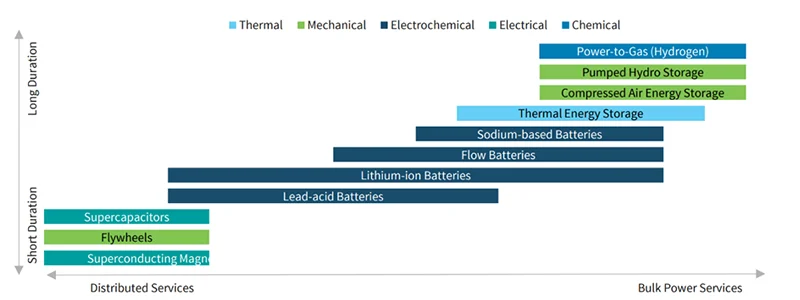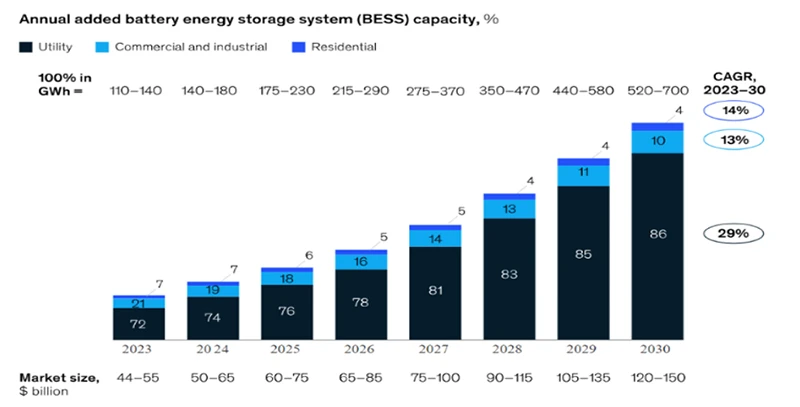An urgent need, a growing market
Despite stiff headwinds, in 2023, clean energy investments reached USD 1.7 trillion, 65% more than fossil fuels. Ambitious transition targets assure investments in renewables and related technologies will rise further. At the COP28 in Dubai, the world agreed to triple renewable capacity by 2030. According to BNEF, energy storage investments must triple to USD 93 billion annually to reach net-zero.1
Renewable but unreliable
Solar and wind are naturally clean and abundant, but their supply is unreliable. Moreover, even when weather conditions are ideal, periods of peak renewable supply don’t always match peak periods of electricity demand. Energy storage bridges the gap by enabling surplus renewable energy generated at peak times to be stored and used later when energy demand is high (but renewable capacity is low).
Too little renewable power when its needed is one problem, too much is another. When solar and wind is strong it can overload transmission lines, leading to congestion, diminished performance and even power outages. As a result, renewables must often be switched off or ‘curtailed’ to avoid system overload. In California, 1.9 TWh of solar generated energy was curtailed in 2022; the equivalent of powering 200,000 homes for an entire year.2 In 2020, the UK curtailed wind energy enough to power over one million homes annually.3
Curtailment not only wastes valuable energy resources, it also threatens to delay the rate of renewable expansion. Grid operators are hesitant to invest further in adding supply when revenues from renewables can’t be fully captured or maintenance costs covered.
No universal storage solution
Energy can be stored in many ways leading to a diverse array of storage technologies (see Figure 1). Technologies range from capturing the energy potential of electrochemical reactions inside battery cells to much larger methods such as the pumped hydropower installations that store the energy potential of water flows between massive reservoirs.
Each technology carries distinct characteristics that can be a strength or a weakness based on the market conditions in which it is applied. For example, supercapacitors use magnetic fields to store and deliver short bursts of high voltage energy, such as for turning EV motors on and off at a stop light. That makes them ideal for emergency back-up power in a hospital or public transport environment.
Figure 1 – Energy storage technologies by type, duration and end-use application

Source: Barclay Research, USAID, NREL, 2021. Distributed services refers to decentralized grids (even micro-grids) where energy must be delivered over smaller distances, small packets and in real-time in response to dynamically changing demand (e.g., residential solar). Bulk power services involve delivery of steady streams of high-voltage energy over long distances to large centralized systems (e.g. municipal coal, natural gas plants) that support base-load demand.
Pumped hydropower is known for its longevity and reliability, making it the most dominant of all installed storage by far. But it is limited to regions that are blessed with abundant water and space. It also suffers from delayed response time, making it less suitable for next-generation energy grids that require near-instantaneous on/off switching. But the biggest trade-offs involve duration and costs.
At one end are technologies that store lots of energy for long durations but which also tend to be infrastructure (and cost) heavy. At the other are those with rapid response times and less infrastructure but also of shorter durations (and costly per unit of energy). Batteries sit somewhere in the middle making them popular for a broad range of use cases.
Bullish on batteries
Thanks to EVs, battery technology has significantly advanced even at the large scales needed for power grids. More importantly, battery costs have dropped 80% over the past decade. Battery storage among utilities is expected to grow 29% annually (CAGR) through 2030 (see Figure 2) and 18% among commercial and industrial energy users such as data centers and hospitals that operate their own energy storage systems.
Figure 2 – Battery storage expected to surge through 2030

Source: McKinsey, 2023. Annual added battery energy storage system capacity, %. Figures may not sum to 100% because of rounding.
Batteries carry other advantages. They are cheap, easy to install, versatile, and – like supercapacitors – can deliver high voltage that can be rapidly dialed up or scaled back. This makes them ideal for helping grid operators cost-effectively smooth out the daily demand-supply imbalances that have intensified with renewable use. Moreover, they can also add to grid stability by taking energy off the grid to curb congestion (i.e., too much energy trying to flow through too few transmission lines). Likewise, batteries can deploy energy at temporary intervals to keep the grid humming at frequency flows mandated by local market laws.
But batteries are not without drawbacks. A storage duration of only 4-6 hours makes many battery types unsuitable for storage over weeks or seasons. Yet long-term storage is critical for fully capitalizing on renewable potential. Other battery types are also in development, these include redox flow, metal-air, and solid-state but while promising, they face grid-integration hurdles that we believe will limit wide-scale commercial deployment.
Investment outlook – storage plus solutions
We are bullish on lithium-ion batteries as they offer the most competitive and versatile solution to for utilities and grid operators. However, to fully capitalize on their potential, they need to be efficiently integrated into new or legacy grid infrastructure, a process that most often requires more layers of expert services. In our view, that puts providers of integrated storage providers and integrated energy operators in the best position to benefit from building structural drivers.
Integrated storage providers bundle storage solutions such as battery power with system integration and digital management services that help dynamically direct grid flows to match demand. Vertically integrated energy operators broaden service-bundling even further. They not only own solar and wind farms but also have the expertise to construct off-the-grid power supplies for remote or power-hungry customers such as data centers. This gives them control over (and revenue streams from) a diverse array of grid-scale services. Moreover, their project portfolios are expanding across geographies.
One of the US’ largest integrated operators with operations in 49 states is developing Florida’s largest solar-powered battery. Similarly, Australia’s leading renewable energy supplier is developing its largest battery project using Tesla-technology. In South America, Chilean operators are adding battery storage next to critical solar installations in the Atacama Desert. In the UK, energy operators are converting grid infrastructure once powered by coal for use as battery storage facilities.
As renewable targets and installations expand, the need for storage solutions is intensifying. Efficient and versatile storage is key. But efficient integration and power-flow management are equally important for maximizing the gains from renewables.
This leaves integrated service providers with the greatest potential for profitably solving grid-storage issues.
We would like to thank Patricia Garcia Abad for her valuable research and contributions to this article.
Footnotes
1BloombergNEF, Energy Transition Investment Outlook. 2023.
2WEF, 2023. ”Storage is the key to the renewable energy revolution”
3Lane, Clark and Peacock, LLP. January 2021. “Is Battery Storage a good investment.”
最新のインサイトを受け取る
投資に関する最新情報や専門家の分析を盛り込んだニュースレター(英文)を定期的にお届けします。
重要事項
当資料は情報提供を目的として、Robeco Institutional Asset Management B.V.が作成した英文資料、もしくはその英文資料をロベコ・ジャパン株式会社が翻訳したものです。資料中の個別の金融商品の売買の勧誘や推奨等を目的とするものではありません。記載された情報は十分信頼できるものであると考えておりますが、その正確性、完全性を保証するものではありません。意見や見通しはあくまで作成日における弊社の判断に基づくものであり、今後予告なしに変更されることがあります。運用状況、市場動向、意見等は、過去の一時点あるいは過去の一定期間についてのものであり、過去の実績は将来の運用成果を保証または示唆するものではありません。また、記載された投資方針・戦略等は全ての投資家の皆様に適合するとは限りません。当資料は法律、税務、会計面での助言の提供を意図するものではありません。 ご契約に際しては、必要に応じ専門家にご相談の上、最終的なご判断はお客様ご自身でなさるようお願い致します。 運用を行う資産の評価額は、組入有価証券等の価格、金融市場の相場や金利等の変動、及び組入有価証券の発行体の財務状況による信用力等の影響を受けて変動します。また、外貨建資産に投資する場合は為替変動の影響も受けます。運用によって生じた損益は、全て投資家の皆様に帰属します。したがって投資元本や一定の運用成果が保証されているものではなく、投資元本を上回る損失を被ることがあります。弊社が行う金融商品取引業に係る手数料または報酬は、締結される契約の種類や契約資産額により異なるため、当資料において記載せず別途ご提示させて頂く場合があります。具体的な手数料または報酬の金額・計算方法につきましては弊社担当者へお問合せください。 当資料及び記載されている情報、商品に関する権利は弊社に帰属します。したがって、弊社の書面による同意なくしてその全部もしくは一部を複製またはその他の方法で配布することはご遠慮ください。 商号等: ロベコ・ジャパン株式会社 金融商品取引業者 関東財務局長(金商)第2780号 加入協会: 一般社団法人 日本投資顧問業協会


















